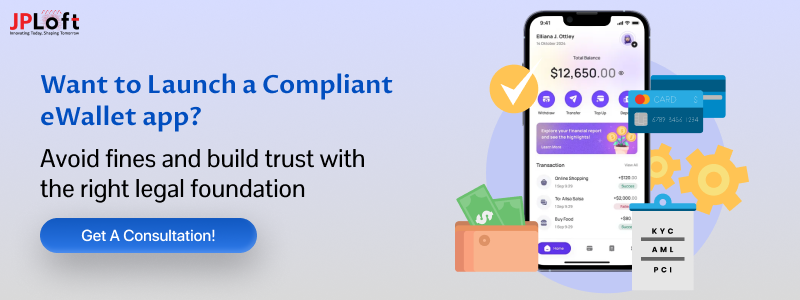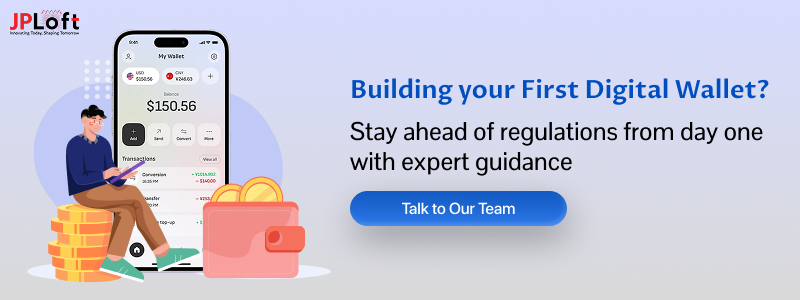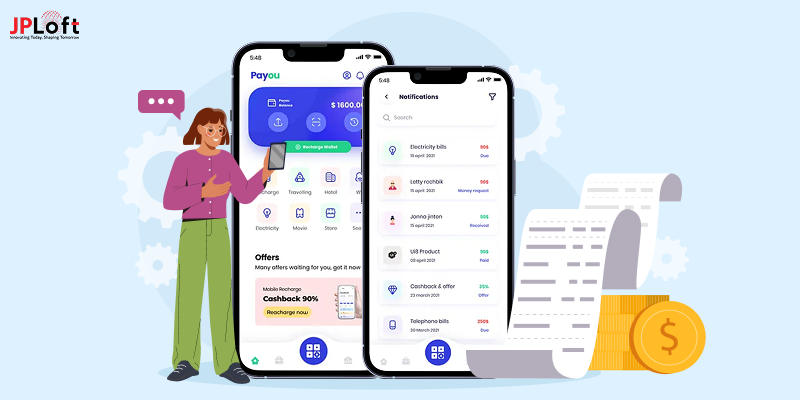Key Takeaways:
Understanding eWallet compliance requirements means meeting legal, financial, and security standards like KYC, AML, PCI-DSS, and data privacy laws based on your target regions and wallet type.
The ultimate compliance checklist for your eWallet app starts with clear KYC and AML protocols and expands into data privacy, PCI-DSS, secure logins, transaction monitoring, and regional licensing.
When it comes to global compliance requirements for eWallet apps, each country has unique licensing, KYC, data storage and AML Laws requiring a region-specific compliance roadmap to stay audit-ready.
If you are wondering where most eWallet apps fail at compliance, then know that startups often skip or delay key elements like KYC, privacy policies, or jurisdictional research, which can result in major legal setbacks.
To stay compliant with eWallet regulations, you can work on compliance from day one, including audits, automation, and legal guidance to scale safety across markets.
Let’s not sugarcoat it: compliance can make or break your eWallet app.
You could have a slick UI, blazing-fast transactions, and the smartest AI fraud detection... but if you miss a compliance checkbox, you’re opening the door to shutdowns, fines, or worse.
So what are the compliance requirements for an eWallet app?
You need to cover everything from KYC and AML checks to data privacy laws, licensing, PCI-DSS certification, and more, depending on where you operate and what kind of wallet you’re building.
And here’s why this matters more than ever:
“Digital wallets are expected to account for over 54% of all eCommerce payment methods by 2026.”
— FIS Global Payments Report
The growth is explosive. The opportunity is real. But the regulatory net is tightening, and skipping over compliance is a risk you can’t afford.
Let’s walk through everything you need to tick off, starting with what eWallet app compliance actually means.
Understanding eWallet Compliance Requirements
If you're planning to invest in an eWallet app, compliance needs to be part of the blueprint—not an afterthought.
So, what exactly are eWallet app compliance requirements?
In simple terms, this refers to all the legal, financial, data, and security standards your app must meet in order to operate safely and legally. This includes:
-
KYC/AML regulations to prevent fraud and money laundering
-
Data protection laws like GDPR, DPDP, or CCPA
-
Licensing requirements from financial authorities like RBI, FCA, FinCEN
-
Payment security compliance, such as PCI-DSS
If you are targeting one country or going global, the compliance for eWallet app requirements shifts based on geography, business model and features.
Skipping even one requirement can get your app banned from app stores or investigated by regulators.
The takeaway? If you want to create an eWallet app that lasts, you need to bake compliance into every stage from development to deployment.
eWallet App Stats You Should Know in 2025
The world’s going wallet-first, not just digital. And the latest eWallet app stats show it: usage, adoption, and transactions are climbing fast across every market.
-
Digital wallets will account for 54% of global eCommerce payments by 2026
-
The global digital wallet transaction volume will reach $16 trillion by 2028.
-
66% of Gen Z and 67% of Millennials are now using digital wallets at least once in the past year.
-
The eWallet market is projected to grow by USD 169.86 billion, with a CAGR of 21.9% from 2024 to 2029.
Want to stand out in this booming space? Great.
But first, you’ve got to get the compliance side of your eWallet app absolutely right.
Next, we’ll break down the full checklist: from KYC, AML, and PCI-DSS to country-specific licensing and ongoing audit requirements.
Ready? Let’s dive into the nuts and bolts.
The Ultimate Compliance Checklist for Your eWallet App
So, you're building or already scaling a digital wallet. That’s exciting. But here’s where many apps stumble: compliance in eWallet app development is not just a checkbox. It’s a layered, ongoing process you can’t afford to skip.
This compliance checklist for eWallet app projects covers all the legal, technical, and operational standards you need to meet.
Follow it closely to stay aligned with regulators, gain user trust, and prevent future breakdowns.
So, what are the compliance requirements for an eWallet app? Let’s break it down.
1. KYC (Know Your Customer) Standards
To comply your eWallet app with regulatory authorities, KYC is non-negotiable.
You must verify user identities before they can transact. Depending on your region, this could involve:
-
Aadhaar, PAN, or passport verification
-
Video-based KYC systems
-
AI-driven ID document checks
-
Age, nationality, and address validation
Globally, regulators demand real-time, fraud-proof identity verification. Not only does this reduce chargeback risk, but it also stops bad actors from using your app for money laundering.
The best way to stay with eWallet KYC compliance? Use it in your user onboarding from day one.
2. AML (Anti-Money Laundering) Measures
If KYC is the front door, then consider an eWallet AML compliance surveillance system
You need to monitor and report suspicious behaviour. That means:
-
Checking users against blacklists (like PEP, OFAC)
-
Flagging unusual transaction volumes or locations
-
Keeping automated risk scores on accounts
-
Submitting SARs (Suspicious Activity Reports)
AML is a massive part of eWallet app compliance, especially in cross-border operations.
If regulators catch you missing a pattern, penalties can range from six-figure fines to license suspensions.
3. PCI-DSS Certification for Card Payments
Handling debit or credit cards? Then PCI-DSS compliance in eWallet app systems is essential.
This global security standard protects payment data. Here's what it includes:
-
End-to-end encryption or tokenization
-
Network segmentation and firewalls
-
Access control for card data
-
Annual audits and penetration testing
Even if you use third-party processors like Stripe or Razorpay, you still need to meet PCI standards for your platform logic, data storage, and API handling.
Want a secure app? The best way to stay with eWallet PCI DSS compliance.
4. Data Privacy & Protection (GDPR, CCPA, DPDP, etc.)
People care deeply about their data, and so do governments.
No matter where you’re based, your app must follow the strictest global data laws, including:
-
GDPR (EU): Full data transparency, opt-ins, and deletion rights
-
CCPA (California): Data sale disclosures, consumer control
-
DPDP Bill (India): Explicit user consent and local data storage
You must clearly explain what data you collect, how it’s used, who can access it, and how users can delete it. And yes, all this must be written in plain language, not buried in fine print.
Following this ensures your app passes the digital wallet compliance checklist for data rights.
5. Secure Login & Authentication Mechanisms
It’s not just about having a strong password. To comply with your eWallet app, security needs to be multi-layered.
Looking ahead, many startups plan to integrate IoT in eWallet apps, enabling secure transactions via wearables, connected vehicles, or smart home devices.
Make sure your mobile wallet includes:
-
Two-Factor Authentication (2FA)
-
Biometric logins (Face ID, fingerprint)
-
Auto-timeouts for inactive sessions
-
OTP-based sensitive action confirmations
Security breaches don’t just cost money; they wreck trust. Include secure authentication early in your mobile wallet compliance checklist.
Besides, as biometric logins become standard, the voice payment trend is also gaining ground.
6. Transaction Monitoring & Anti-Fraud Measures
Your app should never be blind to how users spend, send, or store funds. AI in payments is now essential for real-time fraud prevention, and many apps are embedding AI-driven fraud pattern detection into their core risk systems.
To meet eWallet app compliance requirements, set up real-time:
-
Transaction velocity limits
-
Flagging and freezing suspicious accounts
-
Notifications for high-value activity
-
AI-driven fraud pattern detection
This not only keeps you compliant but makes your app safer to use: a clear competitive edge.
Moreover, emerging use cases of Gen AI in eWallet app security include anomaly detection, auto-flagging suspicious behaviour, and offering personalized fraud alerts based on user patterns.
7. Record-Keeping, Logs & Audit Trails
To pass audits and respond to regulator inquiries, you’ll need detailed logs.
This includes:
-
Every login, transaction, and KYC update
-
IP logs and device details
-
Consent records
-
Admin-level changes
Most regulators require this data to be stored for 5–7 years, depending on your region.
The best way to stay with eWallet app compliance? Automate this from the start using scalable, encrypted log management tools.
8. Dispute Resolution & Chargeback Policies
Problems happen. What matters is how you handle them.
Your compliance checklist for eWallet app must include:
-
A clear refund/chargeback process
-
Regulatory SLA compliance (e.g., 48 hours in India)
-
Transparent grievance redressal mechanisms
-
In-app support with escalation levels
This not only protects you from legal risk but also boosts user satisfaction and ratings. Also, understand that while your eWallet apps will make money through different ways, it is important that those models align with compliance expectations on disclosures and user rights.
9. User Consent, Permissions & Disclosures
You must explicitly get user consent before accessing:
-
Personal data
-
Location services
-
Contacts or SMS
-
Microphone or camera
Avoid dark patterns or pre-checked boxes. Users should know what they’re opting into.
If you miss this, you’re violating both mobile wallet compliance checklist and app store policies and could get banned or penalized.
10. App Store Compliance (Google Play & Apple App Store)
Yes, Google and Apple have their own rules, and they update them frequently.
Once you submit your app to App Store or publish your app to Play Store.
Here’s what to watch for:
-
No misleading descriptions or financial claims
-
User data policies must match your app’s actual behavior
-
Disclose third-party SDKs used
-
Use approved APIs for payment handling
Your app can be technically legal, but still removed for violating store terms. So make app store compliance a fixed part of your digital wallet compliance checklist.
Ensure you're integrating trusted and compliant eWallet APIs that are regularly updated to meet evolving security and data handling standards.
11. Customer Support & Compliance SLAs
This one gets overlooked, but it’s critical.
To comply with your eWallet app's operational regulations, ensure:
-
In-app chat or email support is live during business hours
-
You meet resolution SLAs (usually 24-72 hours)
-
Complaints and actions are logged and timestamped
-
User escalations go to a compliance officer or manager
Support isn’t just about UX; it’s a legal requirement in many jurisdictions. Even the best eWallet apps invest in SLA-backed support systems that meet legal standards for complaint tracking and timely dispute resolution.
And remember: the best way to stay with eWallet app compliance is to treat it as a living system, not a one-time task.
With that being said, let’s check some global compliance requirements for developing an eWallet app:
Global Compliance Requirements for eWallet Apps
If you're launching in multiple regions, a one-size-fits-all compliance plan won’t work.
There are several ways to comply with your eWallet app, and each country brings its own legal expectations, licensing rules, and enforcement agencies.
Some demand full licensing as an EMI (Electronic Money Institution). Others prioritize transaction caps, local KYC norms, or strict data residency laws.
To help you navigate the landscape, here’s a simplified breakdown of eWallet regulatory requirements organized by country.
|
Country/Region |
Primary Regulator(s) |
Key Requirements |
Licenses/Certifications |
|
India |
RBI (Reserve Bank of India) |
Follows PPI guidelines; strict KYC; UPI integration; data localization (DPDP Act) |
PPI License (Prepaid Payment Instrument) |
|
USA |
FinCEN, State Regulators |
AML/KYC compliance; state-wise MSB licenses; CCPA compliance |
MSB License (Money Services Business) in each operating state |
|
UK |
FCA (Financial Conduct Authority) |
PSD2 compliance; SCA; consumer protection policies |
EMI License (Electronic Money Institution) |
|
EU |
Local regulators under EBA & PSD2 |
GDPR data handling; strong customer authentication; cross-border compliance |
E-Money License + PSD2 Registration |
|
Singapore |
MAS (Monetary Authority of Singapore) |
AML/CFT obligations; tech risk management; user fund safeguarding |
Major Payment Institution (MPI) License |
|
UAE |
Central Bank of UAE, SCA |
Onshore and free-zone rules; KYC/AML; license needed for crypto-wallets |
Stored Value Facility (SVF) License |
|
Australia |
ASIC, AUSTRAC |
AML/CTF compliance; real-time monitoring; transaction reporting |
AFSL (Australian Financial Services License) |
|
Canada |
FINTRAC, OSFI |
Registration with FINTRAC; KYC/AML; privacy under PIPEDA |
MSB Registration + Provincial Licensing (if applicable) |
|
South Africa |
FSCA, SARB |
AML/KYC per FICA Act; consumer protection; digital payment caps |
PSP Approval (under SARB guidelines) |
If you’re asking, "How does an eWallet app stay compliant in multiple countries?" — this section should’ve given you a clear roadmap to navigate global laws, licenses, and data regulations.
With that being aside, let’s get to know how eWallet apps fail at compliance.
Where Most eWallet Apps Fail at Compliance (And How to Avoid It)
Just knowing the rules isn’t enough: compliance in eWallet apps falls apart when critical steps are skipped or misunderstood.
If you're serious about scaling globally or even just staying alive in app stores, the cost to develop an eWallet app may seem high upfront, but it’s far cheaper than dealing with any fallout later.
Let’s find out what some of the most common mistakes you can make:
1] Skipping Proper KYC in Early User Flows
Many founders delay full KYC verification, thinking they'll add it "later" once traction picks up. That’s a costly move.
To be very honest, complying with your eWallet app starts with identity. Without it, you risk onboarding fake users, enabling fraud, and falling short of AML regulations.
Regulators can shut you down even before your first funding round if they notice weak verification systems.
This is one of the most common eWallet app development challenges trying to balance fast onboarding with security and legality.
2] Not Understanding Jurisdictional Differences
Here’s the deal: what works in one country doesn’t necessarily fly elsewhere.
Each region has its own eWallet regulatory requirements, and applying one framework everywhere just won’t cut it.
For example, GDPR in the EU focuses heavily on user consent and data minimization, while FinCEN in the U.S. is more focused on AML reporting.
Missing these distinctions will expose you to compliance failures on multiple fronts.
For global-ready apps or wallet-as-a-service platforms, a legal compliance matrix should be non-negotiable from the start.
3] Using Third-Party Tools Without Due Diligence
Many startups rely on third-party KYC, payment gateways, or fraud prevention tools.
That’s fine—until one of those tools violates eWallet data privacy laws or lacks proper certification.
If your vendor fails compliance, your app becomes non-compliant too. You’re liable, not them. Always verify their certifications (like PCI-DSS, ISO/IEC 27001) before integration.
In the end, digital wallet security is only as strong as the weakest link in your tech stack.
4] Overlooking Internal Record-Keeping
You may think compliance is only about what users see: KYC, permissions, pop-ups. But what you log internally is just as important.
A huge mistake is not maintaining detailed audit trails of user actions, admin changes, or payment processing data.
These are critical to meeting both data protection requirements for eWallet apps and financial audit regulations in most countries.
5] Failing to Update Privacy Policies Regularly
When was the last time you updated your privacy policy? Startups often forget that eWallet data privacy laws evolve constantly.
If your app collects new types of user data or integrates new services, your terms must reflect that.
Outdated or vague policies not only get flagged by app stores but also violate GDPR, CCPA, and other privacy frameworks.
6] Assuming Startups Get a “Free Pass” on Compliance
This one’s big. Many early-stage founders assume that as a startup, they’ll be "under the radar" or that compliance can wait until Series A.
Truth is, regulators don’t care about your funding stage.
There are clearly defined eWallet compliance standards for startups, and even a small violation (like mishandling data or missing consent flows) can land you in legal trouble.
7] Neglecting User Consent and Notification Practices
Consent isn’t a checkbox. It’s a full system of communication and control.
One of the most overlooked parts of eWallet app compliance is failing to clearly inform users about what data you’re collecting, why, and how they can manage or delete it.
If your app doesn’t make that easy, you're not meeting data protection requirements for eWallet apps, and your users won’t trust you either.
Now that you’ve seen the most common traps, what do smart founders do differently?
That’s exactly what we’ll cover next.
Best Practices to Stay Compliant With eWallet Regulations
Here’s the thing: eWallet app compliance isn’t just about avoiding fines or ticking boxes for regulators. It’s about building trust, reducing fraud, and making your app credible enough to scale into new markets.
Whether you’re a lean fintech startup or a growing wallet provider, these are the non-negotiable practices that help you stay on the right side of the law and keep users happy.
1. Start With a Region-Specific Compliance Roadmap
Before a single line of code is written, map out the eWallet app legal requirements in every region you’re targeting.
Don’t generalize. FinCEN in the U.S. has very different rules compared to PSD2 in the EU. Make a compliance roadmap for each region and embed it into your dev workflow from day one.
This approach forms the foundation of a strong compliance checklist for eWallet applications.
Pro tip: Leading mobile app development companies are now including compliance consulting as part of their eWallet solutions, worth considering if you're outsourcing.
2. Make KYC and AML Automation a Core Feature: Not an Add-On
The biggest compliance issues usually stem from weak onboarding. Build KYC, AML, and PEP checks into the user journey upfront.
Use smart automation, but always allow for manual review when red flags pop up.
If you're wondering how to make an eWallet app compliant, this is where it begins—by stopping fraud before it starts.
3. Design for Privacy, Not Just Convenience
Don’t collect data “just in case.” Every field in your app must have a purpose.
Stick to the data minimization principle and make it easy for users to control their data. Add simple, user-friendly controls for export, deletion, and consent updates.
Respecting eWallet app legal requirements like GDPR and CCPA isn’t just safe, it actually improves retention and reviews.
4. Get PCI-DSS and Data Security Right, From Day One
If you store or process card details, there’s no workaround. PCI-DSS is mandatory.
Encrypt everything. Use tokenization. Rotate keys. Avoid hardcoding credentials. Run regular pen tests and vulnerability scans.
Startups that follow these rules early align faster with eWallet compliance standards for startups, saving money on future re-engineering and audit fixes.
And if you're planning to start an online eWallet business, integrating compliance right from the MVP stage can save months of backtracking later.
5. Set Up Internal Compliance Roles and Logs
If you’re serious about scaling, you need someone (or a team) responsible for tracking compliance updates, audit trails, and incident handling.
Build dashboards that show login logs, suspicious activity, and consent changes. This isn’t just good ops, it’s required under most eWallet app legal requirements.
6. Stay in Sync With Regulatory Changes
Regulations evolve constantly. RBI, MAS, FCA, and FinCEN often update circulars, and app stores revise their own compliance guidelines.
Subscribe to regulator bulletins and appoint someone to track changes.
Staying compliant also helps you adapt quickly to emerging eWallet app trends, like biometric security or cross-border payments, without legal roadblocks.
This is essential for keeping your eWallet app compliance plan up-to-date and future-proof.
7. Audit Your App Regularly: Internally and Externally
Run internal audits at least quarterly, and bring in external experts annually.
Use this time to review your full compliance checklist for eWallet applications from KYC workflows to API encryption, data storage, and user permission handling.
Regular audits reduce the risk of penalties and give investors and users extra confidence in your brand.
But, truth be told! No matter what your project is, you will need an expert team by your side to make sure you comply with laws.
How JPLoft Can Help You Develop a Compliant eWallet App?
Do you want to build a compliant eWallet App? JPLoft is here to help.
We are the best eWallet app development company with a team of experts, designers, and developers.
From integrating KYC/AML flows to aligning with PCI-DSS, GDPR, and regional licensing needs, we embed compliance into every stage of development.
Launching in one region or scaling worldwide? We align your app with the right legal, licensing, and data standards fast and flawlessly.
Plus, we stay ahead of evolving regulations, so you don’t have to.
Conclusion
In the fast-moving world of digital finance, compliance isn’t just a checkbox, it’s your foundation.
A well-structured eWallet app compliance strategy builds trust, protects users, and keeps regulators off your back.
From KYC to PCI-DSS, data privacy to licensing, every layer matters.
If you're planning to scale, launch globally, or just avoid the costly mistakes others make, now’s the time to prioritize legal readiness.
Use this checklist as your roadmap, not an afterthought. And if you need help building a legally sound, future-proof eWallet app, JPLoft is ready to make that happen: compliance included, right out of the box.
FAQs
To launch a compliant eWallet app, you need to meet several legal and technical requirements such as KYC and AML integration, PCI-DSS certification for handling card payments, GDPR/CCPA/DPDP data privacy laws, secure authentication protocols, audit logging, and country-specific financial licenses.
Yes, KYC (Know Your Customer) is mandatory for any eWallet app that facilitates financial transactions. It helps prevent fraud, identity theft, and money laundering.
If your app handles, stores, or transmits credit/debit card information directly or through integrations, PCI-DSS compliance is required. Building a PCI-compliant eWallet app helps avoid costly penalties and ensures customer data is safe.
Yes, eWallet apps are safe when built with compliance in mind. Encryption, KYC, PCI-DSS, and fraud detection systems ensure secure transactions and protect sensitive user data.
eWallets are secure if used responsibly and developed with proper safeguards like 2FA, biometric login, encryption, and regulatory compliance, offering better protection than traditional wallets or unregulated apps.













Share this blog